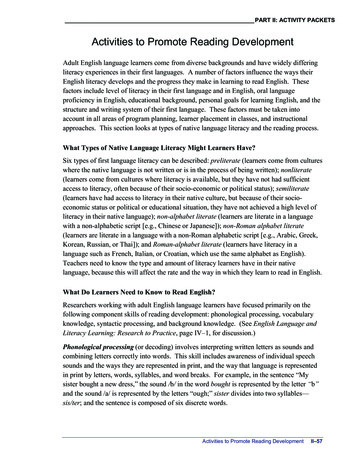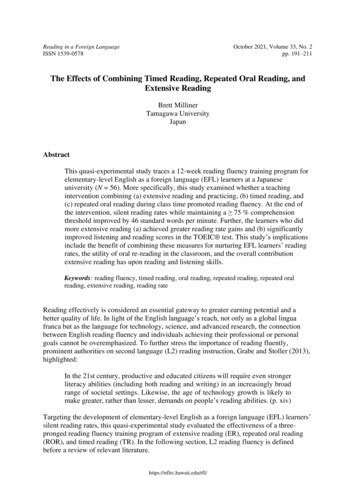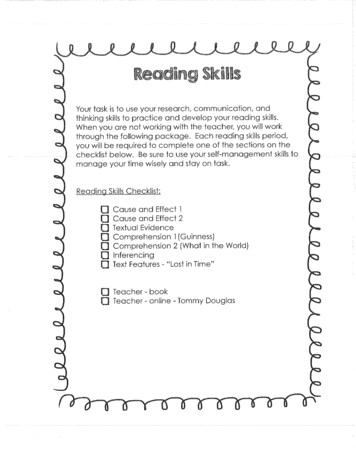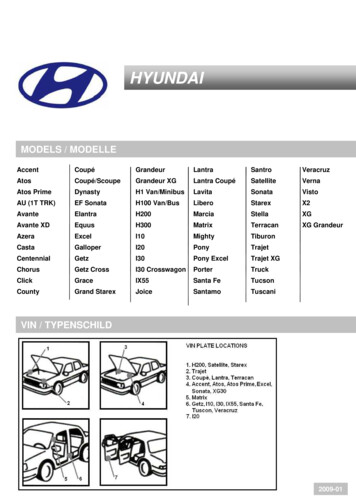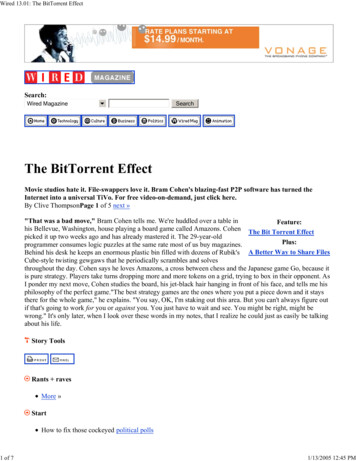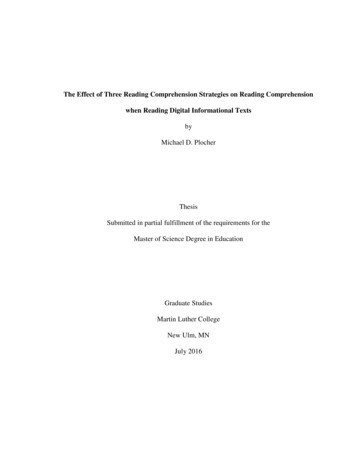
Transcription
The Effect of Three Reading Comprehension Strategies on Reading Comprehensionwhen Reading Digital Informational TextsbyMichael D. PlocherThesisSubmitted in partial fulfillment of the requirements for theMaster of Science Degree in EducationGraduate StudiesMartin Luther CollegeNew Ulm, MNJuly 2016
READING COMPREHENSION STRATEGIESSignature PageDate:This thesis paper has been examined and approved.Review Committee:James Grunwald, ChairCarrie PfeiferPaul TessApproved:John MeyerDirector of Graduate Studies2
READING COMPREHENSION STRATEGIESAbstractThis study explored the effects of three reading comprehension strategies: ClozeReading Comprehension Activity, Reading Road Map (RRM), and Survey-QuestionRead-Recite-Review (SQRRR) on reading comprehension when reading digitalinformational texts. The participants were 48 students in either 7th or 8th grade with 36or 75% of those students having a reading comprehension ability at or above their gradelevel as measured by Scholastic Reading Inventory software. A one-way analysis ofvariance (ANOVA) of the reading comprehension ability of the three groups ofparticipants as measured by Scholastic Reading Inventory software suggested there wereno statistically significant differences in the means of the reading comprehension abilityof the three groups. A non-equivalent groups pretest/post-test comparison group designwas employed that examined the three treatments. The primary analysis evaluatedtreatment effects by conducting a one-way analysis of covariance (ANCOVA). Resultssuggested that the 3 reading comprehension strategies in this study have the same effecton reading comprehension when digital informational texts are read.3
READING COMPREHENSION STRATEGIES4AcknowledgmentsAll thanks and honor belong to my God and Savior, Jesus Christ. He has redeemedme a lost and condemned creature and preserves me richly and daily by providing me withmany blessings, first and foremost is eternal life in heaven with him. For this I strive to livea life worthy of the calling he has given to me.I would like to thank Drs. Jim Grunwald, Carrie Pfeifer, John Meyer, and ProfessorPaul Tess, for their useful comments and encouragement through the learning process ofthis master thesis. I would like to thank my step-father, Dr. Roger Klockziem who helpedme crystalize the topic I wanted to explore and continued to be a sounding board when Ihad questions along the way. I also want to thank St. Paul’s principal, Greg Thiesfeldt, andfellow teacher Steve Biedenbender. Greg, for encouraging me to pursue my master degreeknowing it was something that I had planned to do but struggled to find the time to start,and both Greg and Steve for quietly listening to me talk to them and smiling as Idisappeared out of their classrooms to continue my work. Also, I would like to thank St.Paul’s Lutheran Church for providing financial support towards my master thesis.Finally, I would like to thank my family who have supported me through the entireprocess, and especially my wife, Susan. She was my proofreader, encourager, and friendand would nudge me when needed, always showing love as I worked to put the pieces ofthis thesis together. I will be forever grateful for her love and support.
READING COMPREHENSION STRATEGIES5Table of ContentsAbstract . 3Table of Contents . 5List of Tables . 7Chapter I: Introduction . 8Introduction . 8Problem Statement . 8Purpose of the Study . 9Research Questions . 10Definition of Terms. 10Assumptions and Limitations of the Study . 11Overview . 12Chapter II: Literature Review . 13Introduction . 13Reading Digital Texts . 13Student Interaction with Digital Text . 14Expanded Definition of Literacy . 15Bridging Print and Digital Literacies . 17Summary . 17Chapter III: Methodology . 18Introduction . 18Research Questions . 18Research Design and Procedures . 18Population and Sample . 20Instrumentation . 22Data Analysis Procedures . 23Limitations . 23Summary . 24Chapter IV: Results . 25Introduction . 25Data Analysis . 25Summary . 27Chapter V: Summary, Conclusions, and Recommendations. 28Introduction . 28Summary of Results . 28Conclusions . 29Recommendations . 29Summary . 30
READING COMPREHENSION STRATEGIES6References . 31Appendix A: Research Participation Letter . 34Appendix B: Permission Form . 36Appendix C: Pretest Questions . 37Appendix D: Post-test Questions . 38Appendix E: Likert-type Survey . 39Appendix F: Likert-type Survey Responses . 42Appendix G: Exploring Post-Test Frequency Distribution . 45
READING COMPREHENSION STRATEGIES7List of TablesTable 1: Distribution of Subjects among the Sample Groups.21Table 2: ANOVA Data Summary .22Table 3: ANOVA of Reading Comprehension Ability among Three Groups .22Table 4: ANCOVA Summary.26Table 5: Test for Homogeneity of Regressions .26
READING COMPREHENSION STRATEGIES8Chapter I: IntroductionIntroductionToday there is an ongoing transition from print based texts to multimodal digitaltexts which can be read and interacted with using a variety of devices such as computers,laptops, tablets, Chromebooks, phones and iPods. This trend is also mirrored ineducation. At first colleges and then high schools incorporated digital informational textswithin instruction. Now an increasing number of middle and even elementary schools aremoving towards using digital informational texts for instruction. Wisconsin EvangelicalLutheran Synod (WELS) schools are also following this trend of incorporating digitaltexts within instruction. This may be in the form of e-textbooks or through incorporatingweb-based research activities which require students to investigate and comprehendInternet-based digital informational texts.Problem StatementWhile there is a push to embrace digital texts and leave print texts behind, thismight not be in the best interest of students. The research shows the level of readingcomprehension is mixed at best when students use digital expository or informationaltexts within instruction. Mangen, Walgermo, and Brønnick (2013) demonstrated thatreading linear expository texts on a computer screen leads to poorer readingcomprehension than reading the same text on paper. On the other hand, Aydemir, Öztürk,and Horzum (2013) shared that students reading informational text on a screendemonstrated higher comprehension than students reading from printed materials.Coiro and Dobler (2007) proposed an area of concern regarding the use of digitaltexts in education. They claimed that not enough attention is being paid to how
READING COMPREHENSION STRATEGIES9adolescents develop and demonstrate the literacies needed to read and use onlineinformational texts. If educators are not aware how students read and use digitalinformational texts, they will not be able to provide the type of instruction necessary toensure a high level of comprehension when such texts are used.WELS schools need to move forward in education incorporating the technologyneeded to support what has come to be known as a 21st century education (Kivunja,2014, 2015; Koehler, et.al., 2011; Mishra, Koehler, & Henriksen, 2011). A 21st centuryeducation includes the four Cs of critical thinking, communication, collaboration, andcreativity in addition to the three Rs of reading, writing, and arithmetic (21st CenturySkills, 2009). WELS teachers need to understand and practice sound methods of readinginstruction to ensure the maximum level of learning takes place through the use of digitalinformational texts.Purpose of the StudyDespite the widespread inclusion of digital informational texts within WELSschools, there is inconclusive evidence as to its effectiveness on learning. There is alsominimal evidence as to what the best practices and methods are to ensure digitalinformational texts are used to promote the maximum amount of learning. This studyexplored three reading comprehension instructional methods to determine if their use byWELS educators had an effect on reading comprehension by students as they used digitalinformational texts.
READING COMPREHENSION STRATEGIES10Research QuestionsThis study looked at three reading comprehension strategies: Cloze ReadingComprehension Activity, Reading Road Map, and Survey-Question-Read-Recite-Reviewand answered the following questions:1. What effect will the Cloze Reading Comprehension Activity have on readingcomprehension compared to two other methods when reading digitalinformational texts?2. What effect will the Reading Road Map have on reading comprehensioncompared to two other methods when reading digital informational texts?3. What effect will the Survey-Question-Read-Recite-Review have on readingcomprehension compared to two other methods when reading digitalinformational texts?Definition of TermsThe following definitions are provided to ensure uniformity and understanding ofthese terms throughout the study.Cloze Reading Comprehension Activity. This is a reading comprehensionstrategy in which the teacher provides a sheet of paper with passages from the text inwhich key vocabulary or content words are missing. Students fill in the missing words bythemselves as they read through the text. This activity guides the students through thetext and helps them focus on the content the instructor wishes the students to comprehend(Bormuth, 1968).
READING COMPREHENSION STRATEGIES11Multimodal text. Multimodal text includes the combination of two or moresemiotic systems. These semiotic systems include print, images, icons, audio, and howthese systems are organized within a space (Anstey & Bull, 2010).Reading Comprehension. Reading comprehension refers to the process ofsimultaneously extracting and constructing meaning through interaction and involvementwith written language (Snow, 2002).Reading Road Map. This is a reading comprehension strategy where the teacherprovides a written plan students follow by themselves at times and with a partner at othertimes as they read through an informational text and work on associated activities.(Wood, Lapp, Flood, & Taylor, 2008).Survey-Question-Read-Recite-Review. This is a reading comprehensionstrategy where students independently scan through a chapter turning headings intoquestions, then answer those questions when reading. When done they recite thequestions and answers, and afterwards they review the material they learned whenreading the material (Robinson, 1978).Assumptions and Limitations of the StudyThere were four assumptions made in this study. First, it was assumed thatstudents would have access to their digital textbook for the entire duration of the study.The second assumption was that the reading comprehension methods being studiedwould be used correctly by the participating teacher. The third assumption was thatstudents would answer pretest, post-test, and student survey questions in an honest andcandid manner. The final assumption was that the pretest and post-test questions wouldbe able to be read and understood by participants.
READING COMPREHENSION STRATEGIES12There were four limitations in applying this study’s data to elementary schoolsthat are different than the school involved in this study. First, this study used a sample ofconvenience and not a random sample; furthermore, subjects in this study wereCaucasian, middle class, and came from one school in a Midwestern city. This means theresults would not be generally applicable to a larger population. Second, this studyutilized a pretest. This could have increased or decreased a subject's sensitivity orresponsiveness to the experimental variable. Third, since one teacher was involved, hisbias could have influenced how he presented the various reading comprehensionstrategies to the three groups. A fourth limitation would be the length of time between thepretest and post-test. This study took place over three weeks. Having the pretest and posttest closer together could have yielded more accurate results.OverviewThe remainder of this paper explores what the literature had to say regardingreading digital texts and their comprehension, the methodology used in this study and theresults of this study. Following that is a summary of the study along with conclusions andrecommendations.
READING COMPREHENSION STRATEGIES13Chapter II: Literature ReviewIntroductionCreating meaning from text is a key to learning (Dole, Duffy, Roehler, & Pearson,1991). In today’s world, there is an increasing amount of digital text students areexpected to read in addition to the traditional print text they read. It is understood thatthere are preferences in the way students read and comprehend digital text compared toprint text (Mangen, Walgermo, & Brønnick, 2013). As a result of these preferencespeople usually identify with one of two groups. One group feels that print text on paper issuperior to digital texts on screens. The other group believes digital text is better and willsoon replace print texts. Many educators also find themselves in one of these two groups.Regardless of group affiliation, the concerns with how students read and comprehenddigital text versus print text are still valid.Reading Digital TextsOne concern with reading digital texts is how the speed and accuracy whenreading from screens affects reading comprehension. Other concerns focus on how theability to navigate through and manipulate digital text, along with the non-tactile natureof digital text, affects reading comprehension. Studies that have explored these topicshave led to conflicting results. In one study students who read informational text on ascreen demonstrated higher comprehension than students who read from printed materials(Aydemir, Öztürk, and Horzum, 2013). While another study showed that students whoread linear expository texts on a computer screen had poorer reading comprehension thantheir peers who read the same text on paper (Mangen, Walgermo, and Brønnick, 2013).Additionally, it appears that the format of the digital text, either being long pages wherestudents have to scroll to view the text, or single pages that appear and fill the screen after
READING COMPREHENSION STRATEGIES14a click on a link does not matter as students have shown they equally comprehend digitalinformational text when using either format (Şahin, 2011). These conflicting resultsmight be because many studies used a single variable to identify an issue that affectsscreen readers, where in reality, there is more than one variable involved (Dillon, 1992).Since there are contradicting studies, there must be another variable or variables that areat work.Even though the research is inconclusive in these specific cases, educators need torealize that there are other differences between reading print text and digital text and thatreading comprehension is not necessarily determined by the format or the layout of thetext on the screen. Walsh (2010) reminded us that, “Reading on screen involves variousaspects of online processing that includes responding to animated icons, hypertext, soundeffects, and the continuous pathways between and within screens for Internet andintranet” (p. 214). These additional features of digital text mentioned by Walsh areconsidered multimodal features since they are also used to make meaning. It is theseother aspects of reading digital texts that educators also need to focus on if they are goingto ensure their students can demonstrate they comprehend digital texts when read.Student Interaction with Digital TextToday, we are living in an icon driven world that is filled with video and need torealize our students are no longer used to long paragraphs of text (P. Lee, personalcommunication, March 23, 2015). Many students spend more than two hours per dayviewing screens where they watch videos, play games, and browse the web. They quicklyscan text and other information as they browse online spending less time on a websitethan is necessary to actually read the text on the screen (Houghton, et. al., 2015;
READING COMPREHENSION STRATEGIES15Weinreich, Obendorf, Herder, & Mayer, 2008). Despite these changes in the waystudents view information, reading comprehension and literacy is just as important todayas it was before the expansion of the Internet began in the early 1990s.Other changes have taken place over the past few decades as technology andglobalization helped reshape our economy while emigration has made America moreculturally diverse. These changes require students to be highly skilled at comprehendingtext and masterful communicators as they work with others across cultural lines.(McKinsey Global Institute Report, 2012). Yet, as students spend more timecommunicating with others through a variety of digital mediums and reading informationon screens, the concerns explored by Dillon (1992) are still here; namely, what effectdoes reading digital text on a screen have on comprehension and how does themultimodal component of digital texts come into play?Expanded Definition of LiteracyInformation today is shared and communicated more readily and in a variety offormats than in the past. Educators are aware of the changes in the format of informationand its use and how those changes impact the area of literacy. As a result, they havemodified and expanded the definition of literacy. The literacy model of the past, whichfocused on reading and writing and using those skills in life, has expanded to amultimodal literacy model where print-based texts, digital texts, multimedia texts, andspoken texts now make up the sphere of literacy. Their importance has also been noticedby state educational agencies which in turn have included them in current educationalstandards (Walsh, 2010; Minnesota Department of Education, 2010).
READING COMPREHENSION STRATEGIES16Educators know that students comprehend informational print text mainly throughtapping their prior knowledge, conducting inferential reasoning, and employing selfregulation as they read (Paris & Paris, 2001; Armbruster, Lehr, & Osborn, 2001). Ifstudents become stuck understanding a concept they can make a prediction and keepreading the static text. This type of reading comprehension technique does not alwayshappen on its own when a multimodal component is introduced to the text as is found indigital textbooks and online web pages. Students may end up getting physically lost asthey click on hyperlinks searching for an answer to their prediction. This can in turndecrease their comprehension of the digital text (Coiro & Dobler, 2007). Digital texts,more than print texts, depend on the “design and representation of language and thusrequire a semiotic understanding on the part of the reader” (Rowsell & Burke, 2009, p.117). Therefore, it is not only important to read and interpret the text, but it is alsoimportant to interpret visual clues and master nuances of subtext all while following attimes ideas in a non-linear way as the text is read (Rowsell & Burke, 2009).Realizing that the multimodal component of digital textbooks and web pagescould lead some students to comprehend less when compared to reading printed text,some have worked to uncover the type of skills needed for comprehending digital texts.Newer techniques are needed because of the multimodal component of digital texts(Harris, 2011). Rather than inventing new techniques, it makes sense first to explore ifprint-based comprehension strategies are effective at promoting reading comprehensionof multimodal text as Herold (2014) reports some educators, academics, and technologyvendors are trying to figure out how to do.
READING COMPREHENSION STRATEGIES17Bridging Print and Digital LiteraciesAlong this line of thinking some educational researchers are now promoting thatteachers bridge print literacies and digital literacies using reading comprehension strategyguides. These strategy guides seek to promote student comprehension through a blend ofprint textbook content with related digital content. The Reading Road Map is one suchexample where students follow a written plan that guides them through a printed textbookwhile providing links to online activities (Wood, 2011). Other examples of readingcomprehension guides developed for reading print text that have been shown to improvereading comprehension when print text is used include the Cloze ReadingComprehension Activity and the Survey-Question-Read-Recite-Review Guide. Both ofthese might also have an effect on reading comprehension of digital texts. With theincreased use of digital textbooks, it is important that educators are able to find readingcomprehension strategies that will help students better comprehend the multimodaldigital informational text that is common within and outside of education today.SummaryResearch has shown that there are differences when it comes to reading andcomprehending digital text and print text. Aspects of reading digital text that are not apart of reading print text include video, animated icons, hypertext, and sound effects.These additional features of digital text are considered multimodal since they are alsoused to make meaning. To help students comprehend both digital and print texts it issuggested that educators use strategy guides to bridge the differences between readingprint and digital text.
READING COMPREHENSION STRATEGIES18Chapter III: MethodologyIntroductionResearch has shown that people comprehend digital text differently than print text(Rowsell & Burke, 2009). It has been suggested that educators use comprehensionstrategies to bridge the gap between how students read print and digital text to help thembetter comprehend what they are reading (Wood, 2011). This non-equivalent groupspretest/post-test comparison group study explored three reading comprehension strategiesto determine what effect they might have on reading comprehension when students readdigital informational texts. This chapter looks at subject selection and demographics,instrumentation, data collection procedures, data analysis, and limitations.Research Questions1. What effect will the Cloze Reading Comprehension Activity have on readingcomprehension compared to two other methods when reading digitalinformational texts?2. What effect will the Reading Road Map have on reading comprehensioncompared to two other methods when reading digital informational texts?3. What effect will the Survey-Question-Read-Recite-Review have on readingcomprehension compared to two other methods when reading digitalinformational texts?Research Design and ProceduresThis study followed a non-equivalent groups pretest/post-test comparison groupdesign and examined three treatments. The study began in mid-January 2016 and endedin early February 2016. Data was gathered via a pretest and post-test and was used toanswer the three research questions (see Appendices C and D). Data was also gathered
READING COMPREHENSION STRATEGIES19after the post-test using a Likert-type survey (see Appendix E). This survey helpeddetermine student attitudes and beliefs regarding the method of reading comprehensioninstruction they used in this study.Prior to the start of the 2015-2016 school year the school’s 7th and 8th-gradehistory teacher was contacted and asked if he, along with his students, would beinterested in being a part of this research study. He agreed to participate along with thestudents in the three sections of history that he teaches. Since he is also the school’sprincipal he gave written approval to the researcher to allow this study to take place in hisschool. Written permission was then received from the parents of his students (seeAppendices A and B). This included permission for 52 out of a possible 53 students withone parent declining to have their child participate. Adjustments were made toaccommodate the one student not participating in the study.From December 2015 to January 2016 the 7th and 8th-grade history teacher wasinstructed in three separate sessions in how to use the Reading Road Map and SurveyQuestion-Read-Recite-Review methods of reading comprehension. Each session lastedroughly 25 minutes. The history teacher did not require instruction in the Cloze methodas that was the method he regularly used when teaching his history classes. Hedemonstrated to the researcher how he used the Cloze method. During the study theresearcher observed the principal’s class when he used the Cloze method and found theCloze activity sheets and his use of them consistent with the Cloze method as defined inthis study.To preserve anonymity as data was reported, students in each of the threeclassrooms were assigned numbers as identifiers. On the agreed upon day, a pretest (see
READING COMPREHENSION STRATEGIES20Appendix C) was given to 51 students by the history teacher. One student was absent.The researcher then collected the pretests and tabulated the results. Over the following 28calendar days the history teacher taught two chapters of course material using the digitalDiscovery Education Techbook, World Geography and Culture, in 12 lessons followingthe schedule of three lessons per week. He used a different reading comprehensionstrategy for each of the three classrooms of students when assigning digital textbookreadings. In one classroom students followed a Reading Road Map and wrote downanswers to questions included in the RRM document. In a second classroom studentscreated their own questions from reading heading
Reading Comprehension Activity, Reading Road Map (RRM), and Survey-Question-Read-Recite-Review (SQRRR) on reading comprehension when reading digital informational texts. The participants were 48 students in either 7th or 8th grade with 36 or 75% of those students having a readi




